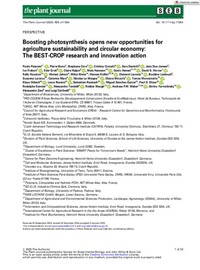Boosting photosynthesis opens new opportunities for agriculture sustainability and circular economy: The BEST-CROP research and innovation action

Authors:
There is a need for ground-breaking technologies to boost crop yield, both grains and biomass, and their processing into economically competitive materials. Novel cereals with enhanced photosynthesis and assimilation of greenhouse gasses, such as carbon dioxide and ozone, and tailored straw suitable for industrial manufacturing, open a new perspective for the circular economy. Here we describe the vision, strategies, and objectives of BEST-CROP, a Horizon-Europe and United Kingdom Research and Innovation (UKRI) funded project that relies on an alliance of academic plant scientists teaming up with plant breeding companies and straw processing companies to use the major advances in photosynthetic knowledge to improve barley biomass and to exploit the variability of barley straw quality and composition. We adopt the most promising strategies to improve the photosynthetic properties and ozone assimilation capacity of barley: (i) tuning leaf chlorophyll content and modifying canopy architecture; (ii) increasing the kinetics of photosynthetic responses to changes in irradiance; (iii) introducing photorespiration bypasses; (iv) modulating stomatal opening, thus increasing the rate of carbon dioxide fixation and ozone assimilation. We expect that by improving our targeted traits we will achieve increases in aboveground total biomass production without modification of the harvest index, with added benefits in sustainability via better resource-use efficiency of water and nitrogen. In parallel, the resulting barley straw is tailored to: (i) increase straw protein content to make it suitable for the development of alternative biolubricants and feed sources; (ii) control cellulose/lignin contents and lignin properties to develop straw-based construction panels and polymer composites. Overall, by exploiting natural- and induced-genetic variability as well as gene editing and transgenic engineering, BEST-CROP will lead to multi-purpose next generation barley cultivars supporting sustainable agriculture and capable of straw-based applications.
